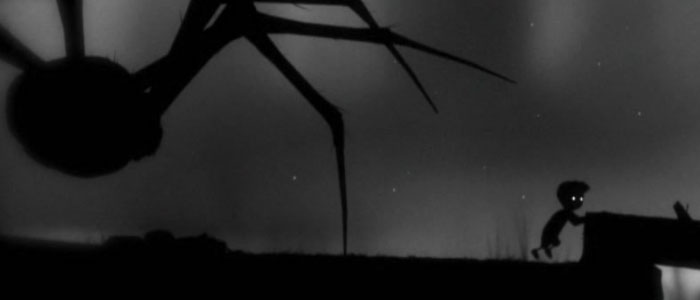Not sure what it is about video games, but we like to play as little boys. From Link to Ico to this nameless little guy, the boyish avatars have met with successively darker struggles. Limbo places you in a fuzzy, black and white nightmare with little explanation and no instruction other than the compulsion to run right. Off-balance from the start, you are quickly introduced to the game’s cruelty the first time you explore just a little too much – and are rewarded with brutal execution.
In Limbo, death is the punishment for just about everything. You will never find yourself scraped up, battered, injured or wheezing. Instead, the little boy is impaled, shot, decapitated, crushed or drowned. Drowned very quickly, in fact. A puzzler, you traverse the environment in side-scrolling fashion, interacting with objects to avoid nasty, gruesome death. Most hazards are carefully hidden, in shadow or disguised within something useful. Timing is increasingly critical to solving the puzzles, which occasionally makes the floaty jumps frustrating. This is mitigated by the frequent auto-saves that keep you safely grounded at puzzle start.
The game is viewed as though through cataracts, a hazy fish eye lens. If, like mine, your 360 produces a gentle roar, you will catch yourself cranking up the volume. It’s not you, it’s not your console, it’s the game – Limbo wants you to be very, very quiet. The sound effects that do crop up from time to time are careful cues to a puzzle’s solution, or even warn of unseen danger. Designed around some basic physics some puzzles use the environment to disguise buttons, some buttons aren’t buttons, and then there’s a little gravity inversion thrown into the mix. Puzzles are amusing in their macabre cruelty, but they lend no sense to the universe.
As for quitting time, Limbo employs a bit of camouflage here courtesy of all those carefully placed autosaves. There’s never really an obvious stopping point, instead you press on, as afraid of quitting as you are of the next booby trap.
Trouble is, at about halfway through I didn’t want to play it. Limbo wants you to connect the dots, even if the dots were never designed to create a picture. There is, ostensibly, no greater meaning, no overarching theme. If you didn’t do some digging, you wouldn’t even know that you’re looking for your sister. Why do you have endless lives? Who built this place? Why are there white butterflies? What giant spider lives on to attack you with only one leg?
The game is experiential, and is not unlike the novella The Birds in making you feel the unexplainable misery of the character as you progress. There are giant spiders, child corpses, child antagonists, but ultimately the environment is the greatest enemy. About halfway through you are moved out of the wilderness and into decaying city structures at the expense of ambiance. Puzzles become more difficult, for the sake of being complex, but you don’t feel the same drive to progress. Rather, you hopelessly press on, clinging to the chance that there will be answers, there will be reward.
But there aren’t any, and there isn’t.
After the first hour the initially artful storytelling falls flat. You no longer want to explore or experiment, and why should you? Limbo trains you that curiosity is punished. It is designed to kill you, to impart death after successive death. The puzzle completion stops feeling like a victory, and starts feeling like a burden. Narrative? There isn’t one. Meaning? There is none. This is an exercise in nihilism.
Review copy provided by publisher.
